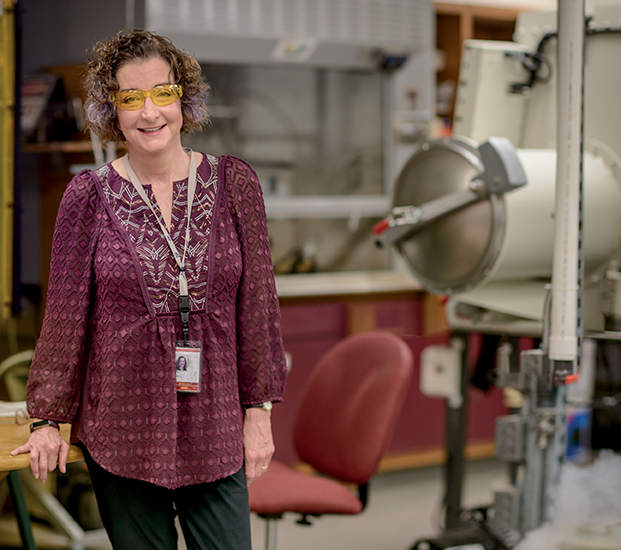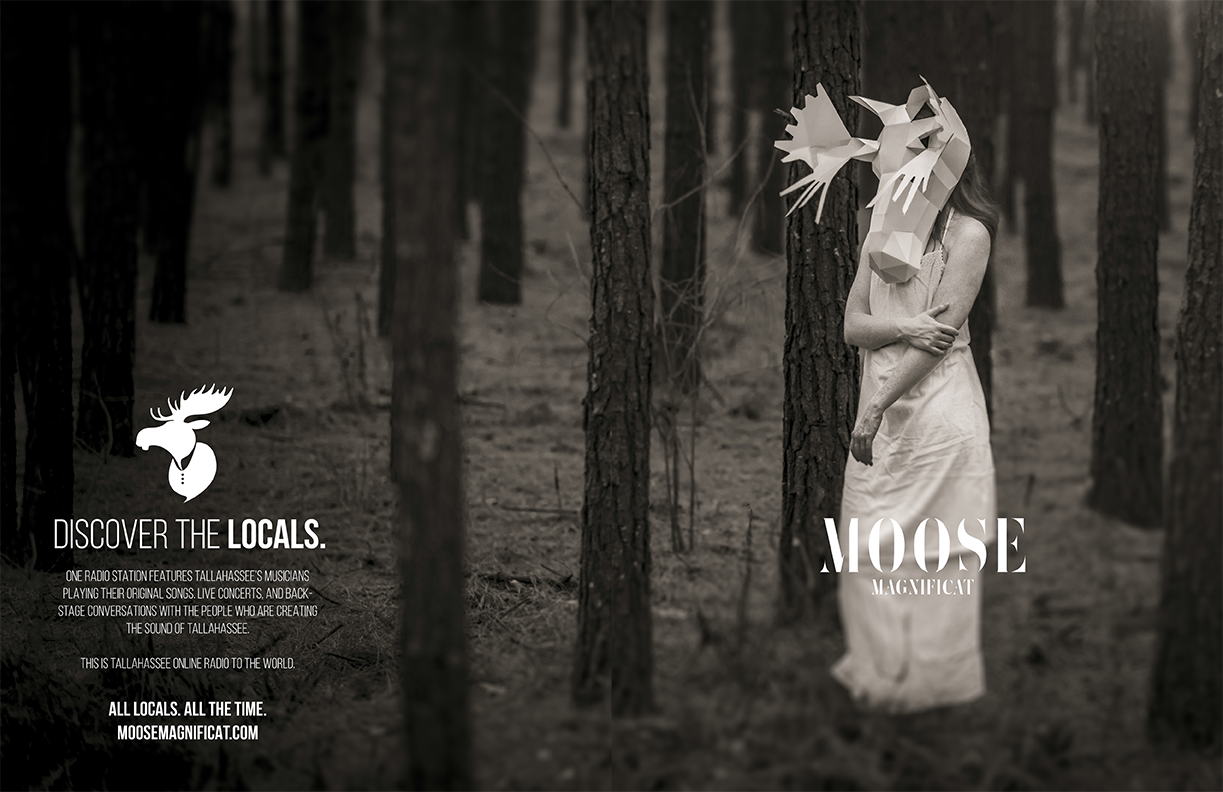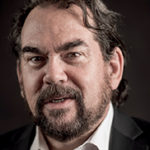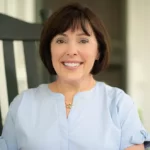By Kristen Coyne
Hired in 2015 as chief scientist , this eminent physicist brings a dynamic array of talents to the MagLab.
Laura H. Greene was hired by Florida State University last year as the Francis Eppes Professor of Physics and chief scientist at the National High Magnetic Field Laboratory. But to better understand the expected impact of this eminent scientist and president-elect of the American Physical Society (APS), it will be helpful to first digress into a sociology lesson, courtesy of bestselling author Malcolm Gladwell. In his book “The Tipping Point,” Gladwell explores how ideas and behaviors spread through societies. For trends to, in modern parlance, go viral, three kinds of people are needed: mavens, the source of the information, knowledge or idea; connectors, who spread ideas through their vast social networks; and salesmen, charismatic women and men who persuade you to believe an idea or adopt a behavior.
If you’re none of the above, you’re among the rest of us, playing a minor role by getting connected, educated or persuaded. Or you’re Laura Greene, that rare specimen who, thanks to her scientific expertise, far-reaching circles, and outgoing personality, is a maven, connector and saleswoman, all wrapped up into a single, high-energy package.
“That to me is what makes her so special: She’s so strong in all three of those areas,” said Greg Boebinger, director of the National High Magnetic Field Laboratory (MagLab). “The contributions she’ll be able to make to the MagLab in getting us plugged in to new spheres of influence will be immense.”
The Maven
Greene’s 82-page CV details the publications (upwards of 200), awards, fellowships (APS and American Academy of Arts and Sciences) and memberships (most notably in the National Academy of Sciences, one of science’s highest honors) that mark a woman at the apex of her profession — a physics maven of the highest order.
Greene happens to study one of the hottest materials in condensed matter physics, high-temperature superconductors, which hold great promise for future energy applications. Ever since their discovery in the 1980s, Greene has been trying to learn exactly how electrons behave in them — one of the holy grails of modern physics.
“I’m really intrigued by fundamentally what’s going on in these correlated electron materials,” said Greene, “and if we could understand them, can we predict their behavior, and can we predict new materials with higher functionality?”
As much as she knows about things such as Andreev bound states and time-reversal symmetry breaking, Greene also stands out for her forays into other areas of science. A member of several multidisciplinary science organizations, she said it makes for good science.
“Some of the discoveries that I’ve made were by just looking at places where people didn’t look before, looking in between — like the cross between chemistry and physics, materials science and physics,” Greene said. “That’s where all the little gems were.”
That approach bodes well for the MagLab, too, said Boebinger, who would like to see more biologists, chemists and engineers among the physicists.
“I think there’s a huge benefit to the lab in getting increased visibility in those other areas of science,” said Boebinger, who has known Greene for close to three decades.
In fact, Greene’s intellectual curiosity ventures well beyond physics. Singing was an early passion for Greene, which still asserts itself in conversation with an occasional outburst of song. A self-taught guitarist and vocalist, the teenage Greene performed in her synagogue’s choir and the folk scene around her native Cleveland.
Since marrying renowned pianist and conductor Ian Hobson 10 years ago, when both held endowed chairs at the University of Illinois at Urbana-Champaign, Greene has picked up a lot about classical music.
“She has a very, very good instinct, a good ear,” reported Hobson from South Korea, where he is completing an appointment at Seoul National University before relocating to Tallahassee and a position at Florida State’s College of Music.
For most of her life, however, Greene’s music has been eclipsed by science. As a child she watched Carl Sagan and Mr. Wizard on TV, plastered her bedroom walls with astronomy posters and avidly followed the space program.
“I remember when I started kindergarten that I already had all the distances of all the planets to the sun and from each other memorized,” she said.
Still, predilection isn’t destiny, and circumstances conspired to try to kick Greene off the road to science. For starters, she didn’t do particularly well in science in high school, which she chalks up to dull coursework and her music gigs. So by the time she discovered physics as an Ohio State University freshman, she lagged behind her peers.
Petrified of failure, Greene drew on a determination that has boosted her over hurdles throughout her life. Lacking the required background in trigonometry, she aced a six-week crash course. When she needed extra help, she made sure she got it.
“She was extremely committed, hardworking,” recalled her major professor, James Garland. “Quite a remarkable person, really.”
Though Greene could rely on her grit to master coursework, she had less control over a climate that discouraged women pursuing science. When she looked into an engineering major, she was warned she would never find a job. While the physics department chairman was more welcoming, the facility itself, lacking a single restroom for women, was not. Even Greene’s parents opposed her choice of major as both impractical and unpalatable to prospective husbands, said Marcia Milchiker, one of her two sisters.
“My parents actually felt, because there were three girls, we should all become teachers,” said Milchiker, who, like her baby sister, ended up with a science degree nonetheless. “So that if anything happened to your husband, you could make money and be in school the same time your children were in school.”
Against these snags, Greene deployed three strategies. First, she worked very hard. Second, she didn’t dwell on the negative, finding an upside even to prejudice: Being dismissed on account of her gender made her feel freer to ask questions, she said.
Third, she got a little help from her friends. “If you are a minority — and women are minorities (in the sciences) — you do kind of feel left out and you may not get the networking you need,” Greene said. “It can be really lonely. I really encourage young women to find girlfriends. I don’t know what I would have done without my girlfriends in graduate school.”
The Connector
Girlfriends, sisters, two sons (both studying geochemistry), a husband, seven stepchildren, numerous collaborators, postdocs, students, colleagues, acquaintances: The threads in the web at which Laura Greene is the nexus are too numerous to track.
Greene has chaired, co-chaired or sat on more than 100 search committees, advisory panels, review panels, editorial boards and the like, leaving one to wonder if there remains a single physicist of any consequence whom she has yet to meet.
“I have a hard time saying no,” said Greene, who has nonetheless started to do so to devote more time to Florida State and the MagLab. There’s a reason Greene is so sought after: She dives into assignments many of her peers simply slog through.
“A more typical response is, ‘Oh, this is one of four things I have to do this week. I’ll try to get through this as fast as I can,'” Garland said. Greene, however, embraces the work.
“I think whatever she is interested in at the moment is the most important thing in the world for her.”Managing a demanding schedule of his own, Ian Hobson admires his wife’s work ethic.
“She is absolutely single-minded when it comes to these things,” he said. “She doesn’t dabble about things and let them go.”
The exception to that rule is social media. She posts infrequently on Facebook and, after discovering last year that her long-neglected Twitter account had been hacked, shut it down for good. Her connections are measured not in tweets and followers but in trips and miles traveled — about 100 and 300,000, respectively, last year alone, according to Greene. She prefers the face-to-face chat, the personal touch.
While most of us might manage a phone call or social shout-out on a distant sibling’s birthday, Greene jetted into town on her sister’s birthday last year, took her to dinner, then flew back to her packed schedule the next day.
“She can buy a house, she can sell a house and run a big conference all at the same time,” said sister Elinor Greene, “and still have time to listen to a problem I’m having personally or at work.”
Greene has the frequent-flier lifestyle down to a science, packing sensible snacks in her red carry-on, and reusing the same easy-care wardrobe trip after trip. She also skillfully manages priorities and brain bandwidth. Too busy to bother with more, she made do for months with little more than a bed in her new Tallahassee home. After briefly considering a new outfit for her travel wardrobe, she dismissed the time-sucking idea before redirecting her neural network to a more important task.
Greene doesn’t pretend to have the perfect work-family balance.
“There is no balance,” Greene once told an interviewer. “It’s a constant state of semi-controlled crash. You do the best you can. Keep a sense of humor and throw money at it.”
The Saleswoman
Along with honesty, a strong work ethic and intelligence, a sense of humor is key to Greene’s personality. It’s part of what makes her good at what she does.
One only need observe her in action at an annual APS meeting. Greene dusts off her smoky alto at the event’s singalongs, crooning lyrics at once brainy and silly and best appreciated by fellow physicists. Throughout the gathering, old and new friends, colleagues and students are drawn to her, her renown made less intimidating, perhaps, by her corny physics jokes and easy smile.
“Laura will tend to be the center of attention,” Garland said. “She’s the person who tends to drive the conversation. If she sees someone who is ill at ease, she will seek them out and try to make them comfortable.”
Even as a young scientist, Greene defied the introverted stereotype, sporting pink high-tops and bringing the fun to parties along with her famous broccoli casserole.
“She just wouldn’t look like a physicist,” remembered Elinor Greene, who became the first in the family with Florida State ties with a Ph.D. in instructional systems design. “Her style is confidence.”
That confidence serves her well as a seller of science. Whether inspiring her nephews to do science fair projects on superconductivity, working within the APS on outreach initiatives, or lobbying her congressional representatives for more funding, Greene is a powerful science ambassador.
Having grown up during the space race, Greene feels it is important to convey not just the facts of science, but the excitement.
“I didn’t go into science because I wanted to study superconductivity,” she said. “I went into science because it was science. So if you get excited by stars or planets or science fiction — which many of the early physicists who worked on the Manhattan Project did — that’s OK.”
Greene’s own career is an advertisement for how exciting the profession can be, particularly those first, frenzied years of high-temperature superconductivity research. In 1987, an adrenaline-filled year for anyone involved in that exploding area of research, Greene once sped across New York’s Long Island in an effort to be the first to submit and publish a new finding, and later presented her research to a packed ballroom at an APS meeting so mind-blowing it was later dubbed the Woodstock of Physics.
That passionate young researcher is today president-elect of an organization representing 51,000 fellow physicists across the country. Having such a high-profile leader in Florida State’s Department of Physics is an almost guaranteed boon, said department chair Horst Wahl.
“Whenever somebody of her caliber joins the department, that helps the visibility and reputation of the department,” Wahl said. “Even if she didn’t do anything for the department.”
Little chance of that: Greene has already voiced interest in teaching, supervising graduate students, developing curricula, and helping develop an interdisciplinary program in materials science, arts and design. Ambitious goals for someone also heading up science at the MagLab, but Wahl is not putting it past her.
“She has shown us that she is apparently able to ride 10 horses at the same time,” he said.
As APS president next year, Greene intends to focus on human rights. United by their love of discovery, physicists have an important role to play, she said. She recalled a recent meeting in Oman that drew a diverse group of scientists — Indians, Pakistanis, Palestinians, Omanis, Yemenis, Sunnis, Shiites, Jews.
“We get together from very disparate backgrounds that on paper should not be getting along at all,” she said. “But we typically don’t give a hoot about that. We just care about interacting over science.”
The idea of a bunch of physicists helping bring about world peace may sound like a pipe dream. But there may be no one better equipped than Laura Greene to chase it.
Kristen Coyne loves writing about science, research and discovery at the National High Magnetic Field Laboratory.
Originally published in “Across the Spectrum,” the alumni magazine of Florida State University’s College of Arts & Sciences.











